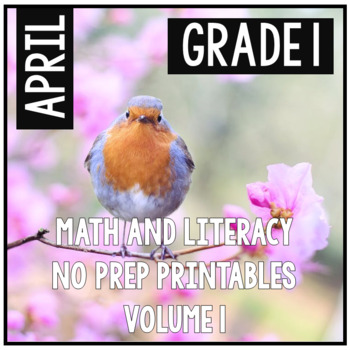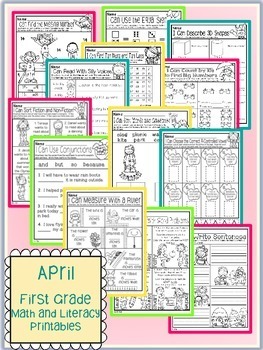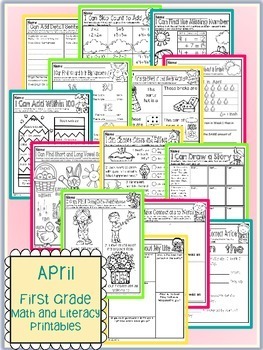April Easter Spring First Grade Math and Literacy NO PREP
- Zip
Also included in
- This unit contains both a printable packet version AND individual JPEG files for each document so that you can easily upload to Google Classroom. Since they are in JPEG format, students should be able to write on the documents in Google Classroom.To find our other First Grade math and literacy materPrice $20.00Original Price $25.00Save $5.00
Description
This unit contains both a printable packet version AND individual JPEG files for each document so that you can easily upload to Google Classroom. Since they are in JPEG format, students should be able to write on the documents in Google Classroom.
To find our other First Grade math and literacy materials, click HERE!
This great math and literacy packet has 40 printables just for first grade - 20 math and 20 literacy. They can be used in so many ways! It is an Easter and spring themed packet, so it will be perfect for your April lessons!!
This will be perfect for your math centers, literacy centers, morning work, homework, RTI, or even for enrichment for those early finishers you have!
It is common core aligned and each common core standard is printed right there on the bottom of the page so that you don't have to search for standards.
It is a print and go packet, meaning that you can print and hand out - no prep needed. Every sheet is labeled with an, "I Can" statement so that your students can easily see their learning goals for the day. Answer keys are included for all necessary sections, so you can easily check work or even allow students to evaluate their own work. Thank you so much for checking out this packet and I hope that you will look in my store for other activities and packets!
Included in this packet:
I Can Solve Word Problems - 1.OA.A.1 - Students will solve two word problems and show their thinking.
I Can Find the Missing Number - 1.OA.B.4 - Students will find the missing number in subtraction equations and color to find their answer.
I Can Skip Count to Add - 1.OA.C.5 - Students will use skip counting to solve addition equations within 100.
I Can Add Within Twenty - 1.OA.C.6 - Students will solve addition equations within twenty and color by the code.
I Can Use the Equal Sign - 1.OA.D.7 - Students will find the correct number to make each side of the equal sign equal.
I Can Find the Missing Number - 1.OA.D.8 - Students will find the missing addend within twenty.
I Can Compare People By Height - 1.MD.A.1 - Students will compare four people by height to solve a logic puzzle.
I Can Measure With a Ruler - 1.MD.A.2 - Students will measure pictures with the pictured rulers to find how many inches each one is.
I Can Answer Questions About a Graph - 1.MD.C.4 - Students will read a rainfall graph and answer questions about rainfall in the month of April.
I Can Describe Shapes - 1.G.A.1 - Students will solve a logic puzzle by finding the correct description of each shape.
I -Can Find Shapes in the Real World - 1.G.A.1 - Students will describe real world items using 3D shapes.
I Can Describe 3D Shapes - 1.G.A.1 - Students will determine the name of each 3D shape, tell how many faces, and give an example of something with that shape.
I Can Break Down Big Numbers - 1.NBT.B.2 - Students will write the number name, fill it in on a hundreds block, and write in expanded form for two-digit numbers.
I Can Count By 10s to Find Big Numbers - 1.NBT.B.2c - Students will count fingers on hands (by tens) to find how many fingers all together and how many sets of ten.
I Can Find 10s and 1s in Big Numbers - 1.NBT.B.2c, 1.NBT.B.2b - Students will find how many tens and ones in teen numbers and multiples of ten.
I Can Compare Numbers - 1.NBT.B.3 - Students will compare two two-digit numbers using symbols.
I Can Compare With Word Problems - 1.NBT.B.3 - Students will read word problems in which they add to find out how much of something each person had, then decide and color to show who had the most and who had the least.
I Can Add Within 100 - 1.NBT.C.4 - Students will solve multi-step addition equations.
I Can Add Two-Digit Numbers - 1.NBT.C.4 - Students will solve equations adding two two-digit numbers (one two-digit number and one multiple of ten) and solving to find the answer to a spring riddle.
I Can Find Ten More and Ten Less - 1.NBT.C.5 - Students will solve equations to find ten more and ten less of two-digit numbers and find the answers on a grid, coloring to show a spring picture.
I Can Find Short and Long Vowel Sounds - RF.1.2a - Students will color to find short and long vowel sound words.
I Can Sort Long Vowel Sounds - RF.1.3c - Students will color to show if words are long a, long e, long i, long o, or long u words.
I Can Read With Silly Voices - RF.1.4b - Students will read sentences using given silly springtime voices to practice fluency.
I Can Choose Cause and Effect - RI.1.3 - Students will answer multiple-choice fill-in-the-bubble questions to show cause or effect of each mini story.
I Can Put a Story in Order - RL.1.2 - Students will read the Itsy-Bitsy Spider song and cut and paste to show the correct sequence and also finding pictures showing things that did not happen in the rhyme.
I Can Sort Fiction and Non-Fiction - RL.1.5 - Students will read to find out what kind of book each person is looking for, then color to show if they want fiction or non-fiction.
I Can Draw a Story - RL.1.7 - Students will read mini stories and draw to show what happened first, next, and last.
I Can Create Verbs, Nouns, and Adjectives - L.1.1b, L.1.1e, L.1.1f - Students will find nouns, verbs, and adjectives for each letter of springtime words.
I Can Use Conjunctions - L.1.1g - Students will choose the correct conjunction to complete each sentence.
I Can Choose the Correct Article - L.1.1h - Students will choose the correct article to complete each sentence.
I Can Use Prepositions - L.1.1i - Students will read each sentence and illustrate to show what it says. Then they will write a new sentence about the picture using the preposition.
I Can Write Sentences - L.1.1j - Students will write sentences to describe each spring picture.
I Can Find Complete Sentences - L.1.1j - Students will determine if sentences are complete or incomplete and color to show their answer.
I Can Create Questions - L.1.1j - Students will create questions that fit the given springtime picture answers.
I Can Sort Words Into Categories - L.1.5a - Students will sort words by season.
I Can Make Connections to Words - L.1.5c - Students will create similes to show that they understand real-world connections to given adjectives.
I Can Understand Shades of Meaning - L.1.5d - Students will read and color to show that they understand shades of meaning in adjectives.
I Can Choose the Correct R-Controlled Vowel - RF.1.3 - Students will determine if R controlled words are "ar" or "or" words and cut and paste to match their description.
I Can Write About My Life - W.1.3, W.1.8 - Students will write to answer journal questions about their life.
I Can Add Detail Sentences - W.1.5 - Students will write detail sentences to go with topic sentences.






